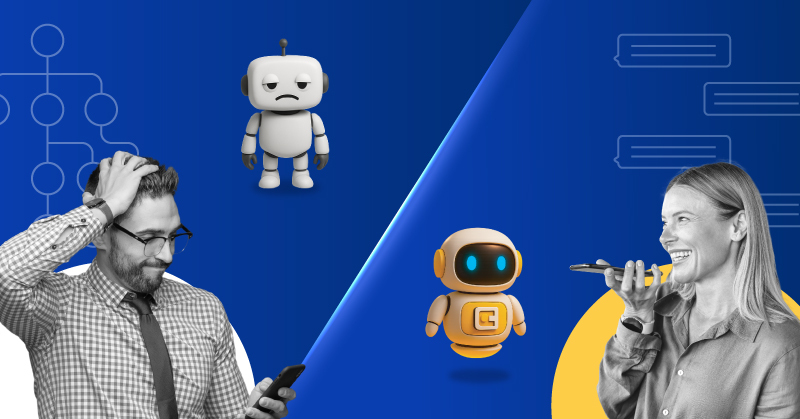How Can Conversational AI Humanize the Digital Banking Experience?
Digital banking has been around for a while – to keep at par with the growing customer demands and meet the expectations of digitally-savvy customers. Especially the post-pandemic period has seen many banks and financial institutions willingly adopting advanced technologies to ensure customer retention and drive sales.
Juniper’s research says that by 2024, the total number of online and mobile banking customers will exceed a surprising figure of 3.6 billion.
This digital transformation calls for solutions that allow banks to connect with customers in different ways and ensure a personalized and humanized customer experience. This is where conversational AI comes into play.
This article will show the importance of humanized banking experience, its benefits, and how conversational AI assistants help banks achieve it.
The Need for Humanized Banking Processes
According to PWC, 80% of customers state that they would shift to another financial institution for a better support experience, irrespective of the costs. So, the need to humanize banking processes ultimately boils down to delivering an exceptional customer experience and ensuring maximum retention.
Banks need to deliver a compassionate customer interaction that exceeds or equals the experience offered in the branches—to survive in this “new normal.” The emotional impact due to digital banking plays a crucial role in customer engagement.
Customers today don’t just expect speed and accessibility, but a way to make them feel good and special when interacting with technology—which is possible due to human touch or a human element.
Banks need to comprehend how the customer’s needs and preferences have evolved over time and use these insights to create strategies that adapt to the changing and new customer behaviors.
Conversational AI solutions like a conversational AI chatbot helps banks engage with customers in a human-like manner with personalized, omnichannel, multi-language, and 24×7 end-to-end experiences.
Ways conversational AI humanize digital banking experiences
Here’s how conversational AI helps banks strike the right balance between digital innovation and humanized and natural engagement across all banking channels.
1. Personalization
Customers are getting more and more demanding. According to Accenture, one in two customers expects customized advice from the banks based on their specific individual circumstances and real-time changes.
This is where conversational virtual assistants shine and offer individualized customer support by better anticipating customer needs and taking off the burden from banking agents.
Conversational AI helps banks deliver a powerful and meaningful personalized customer experience using insights, existing customer data, and everyday customer touchpoints. This human-like digital banking experience increases customer satisfaction and makes them feel valued.
2. Omni-channel integration
Time is money, and the digital revolution has only made people more impatient than ever. Banking or not—customers seek speed, convenience, and a human-like customer experience.
They demand individualized attention with the ability to conduct transactions and get banking assistance in a way that is most convenient to them. The digital baking experience must be seamlessly and completely integrated with a physical one to achieve this.
For instance, conversational AI’s chat tools for customer support can help customers to book an appointment through a website or on an app or access a preferred banker, qualified professional, or wealth manager at any time of day.
3. Servicing, engaging and acquiring
These are the three main areas in banking where conversational AI can take customer interactions to a whole new level of engagement.
Servicing
Conversational virtual assistants handle common customer queries and inquiries to improve operational efficiency and offer a human-like experience—reducing wait times and call center volumes.
These common inquiries may include:
- How to check my bank balance?
- How to make a mobile deposit?
- Where can I find the nearest ATM?
Engaging
An intelligent AI conversion assistant also allows banks to offer additional banking services and strengthen customer relationships and loyalty.
For instance, customers can:
- Receive upcoming payment alerts.
- Create, track, and get custom notifications on personal financial goals.
- Initiate the payment process upon receiving the alert.
Acquiring
Smart conversion lets customers find new and relevant products and services contextually—increasing their value and retention.
As a result, customers can easily perform these tasks:
- Activate a credit card.
- Expand their credit limit.
- Schedule appointments.
- Apply for a new loan or a credit card.
Conclusion
Humanizing digital experiences is essential for banks—to augment growth and deliver exceptional customer service, especially in the post-COVID age.
Banks can create and build stronger customer relationships by offering a seamless omnichannel experience and adding a personalized touch in the digital interactions through conversational AI virtual assistants—leading to higher customer retention and acquisition.
You can automate your banking processes through interface.ai automation. Our smart conversion allows you to assist your customers in a human-like and natural conversational manner, prevent customer drop-offs, and increase conversion by over 500%.
So, avail of our intelligent AI services for your bank’s growth, increase revenue and win a competitive edge over your competitors.
AI Insights for Credit Union & Community Bank Leaders
Join the monthly newsletter for all the latest industry updates


